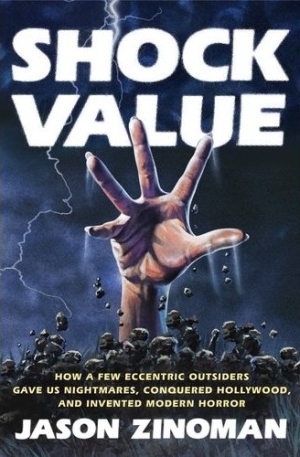Shock Value by Jason Zinoman
Flesh-eating zombies, homicidal maniacs, predatory aliens and supernaturally afflicted teens are so ubiquitous in popular culture today that it can be difficult to envision a time when horror wasn’t a billion dollar industry or when having a relentless serial killer in your film precluded it from Oscar consideration.
 This wasn’t the case in the ’60s, when horror movies were dismissed as having little cultural currency and studios balked at spending large sums of money on any scary movie that couldn’t be pedaled as high art. So-called “Horror” films that were made were done so cheaply and seen as a form of sleazy indulgence, or at best, silly adolescent escapism.
This wasn’t the case in the ’60s, when horror movies were dismissed as having little cultural currency and studios balked at spending large sums of money on any scary movie that couldn’t be pedaled as high art. So-called “Horror” films that were made were done so cheaply and seen as a form of sleazy indulgence, or at best, silly adolescent escapism.
Enter George Romero, Wes Craven, John Carpenter and a handful of other young, eccentric filmmakers whose grim and confrontational visions revitalized the genre and laid the groundwork for what is modern horror today.
Shock Value by Jason Zinoman chronicles the rise of this new crop of directors and writers, and the messy, troubled circumstances under which many of their classics were birthed. He accounts their personal histories, ponders how these informed their seminal works (Night of the Living Dead, Rosemary’s Baby, The Exorcist, Halloween, Carrie, The Last House on the Left, The Texas Chainsaw Massacre, to name but a few), and attempts to relate them in a cohesive way to the cultural backdrop of the 60s and 70’s.
Zinoman’s research is thorough and his portraits of these pioneering filmmakers at the early stages of their lives & careers is quite fascinating– Brian De Palma as a troubled, voyeuristic youth, John Carpenter and Dan O’ Bannon as ambitious film students, Wes Craven as a young husband and father struggling to reconcile familial obligations with his need to re-invent himself through his writing.
The book also gives a compelling case for how the new crop of films differed from before, particularly how the ambiguity surrounding the villains and their motives play psychologically upon the audience—”the most frightening thing is the unknown, the inability to understand the monster right in front of your face.”
I appreciated getting insights into the collaboration and conflict that went into the making of these movies, for example, the competing ideologies between the director of The Exorcist and its original author, and how that informed the final cut of the film.
At times the connections between the filmmakers feels a bit forced, and there are also few glaring omissions from the dramatis personae (Where is David Cronenberg with his distinctive brand of body horror? Can Sam Raimi get more than just a quick mention?).
The book also feels like it ends prematurely– Zinoman infers that the horror industry, for all of its guts and glory, is still wary of breaking certain cultural taboos (as he learned when pitching a film treatment involving an adulterous woman having a miscarriage), and implies that it is this very urge to upset people’s cultural sensibilities that made the original films of the 60s/70s so groundbreaking. I would have liked to hear him expand on this a bit more, and perhaps reflect on recent films that were effective in this regard.
Overall, the book stands as a highly enjoyable and informative account of a largely overlooked period of genre filmmaking, and a fitting-if-occasionally-fragmented tribute to the enterprising young creatives who pioneered it. One need not even be a fan of horror— anyone moderately interested in the process of filmmaking or exploring the role of psychology in creating and consuming art will find something to appreciate.
You can get Shock Value here.







